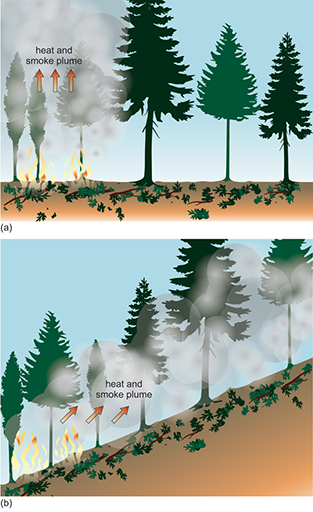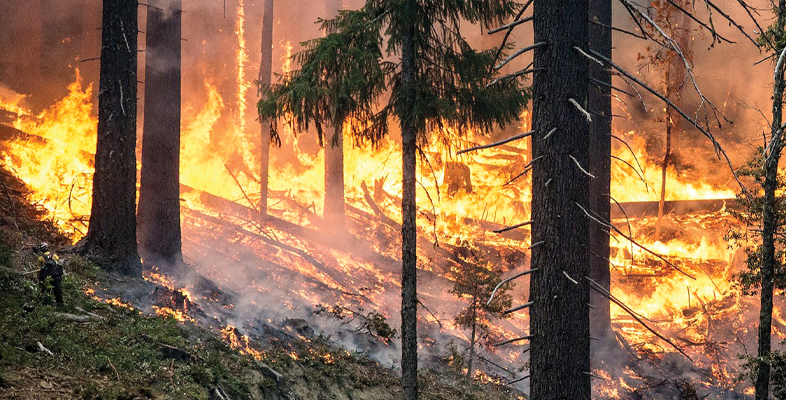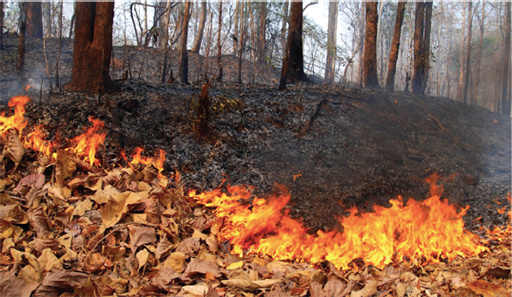1.4 Fire severity
What determines fire severity is mainly the temperatures reached and the speed at which the fire spreads. These in turn are a function of climate, vegetation, topography and soil. A source of fuel is the first prerequisite for fire and must be dry enough to burn. Hot dry and windy weather conditions are key driving factors influencing fuel moisture, which is why primary rainforests virtually never burn naturally. A few days of hot dry weather is sufficient for dry tall grasslands to sustain a fire whereas months of extremely hot and dry conditions are needed to burn tropical forest. This means that fires in tropical forests are associated with rare prolonged drought events such as those produced by El Niño conditions. Grasslands on the other hand, burn frequently and tend to burn after high rainfall years when long grass and hence fuel is abundant.
The type of vegetation is also an important determinant of fire severity. Dead litter has the lower moisture content compared to live vegetation and so will burn more easily but the shape and size of plant parts also influence moisture content and hence flammability. Species such as Pinus spp. with narrow leaves and thin branches burn readily. Also, the high wax or oil content of these species mean that they burn at especially high temperatures.
The rate of fire spread, and to some extent its severity, are influenced by wind speed. Fires also move faster up slopes than over level ground. The rate of spread approximately doubles for every 10° increase in slope (Figure 1).

Finally, the amount of organic matter in the soil can affect fire severity. Where the soil has a high content of organic matter (e.g. peat or landfill sites), a severe fire can cause the soil itself to smoulder, sometimes for weeks and in the case of peat fires, even years. Peatlands store a large amount of CO2 which is released into the atmosphere when peat burns. Peat fires in south-east Asia (1997, 1998, 2002, 2013, 2014 and 2015) are believed to have accounted for up to 40% of global CO2 emissions in each of those years.
In general, there are three categories of fire severity:
- low severity surface fires
- high severity stand replacement fires
- mixed severity fires.
Low severity surface fires (Figure 2) are usually frequent and burn surface fuels at low intensities, causing low understory vegetation mortality. They are commonly used for land management (as on heather moors); soil surface temperatures rarely exceed 200 °C and litter is scorched but not always consumed. They predominate in grassland and savannahs and burn naturally at annual intervals or in some cases even more frequently than that.
Forest ecosystems surface fires that burn only the lowest vegetation layer and may be composed of grasses, low shrubs, herbs, mosses and lichens (surface fuels), are often called understory fires.
High severity stand replacement fires reduce or kill the majority of the dominant vegetation, they contain both surface fires and active crown fires that burn most of the crown of dominant plants, usually trees, and usually ascend from the ground into the forest canopy. They are influenced by wind topography (the way the terrain influences wind speed and direction) and tree density and are the hottest and most devastating: temperatures at the soil surface may reach 800 °C and all litter is consumed, leaving bare earth.
Finally, mixed severity fires contain elements of both surface and passive and active crown fires mixed in time and space. Passive crown fires (in which only the crowns of individual or small groups of trees burn), patchy stand replacement fires and low intensity understory/surface fires are common in mixed severity burns.

